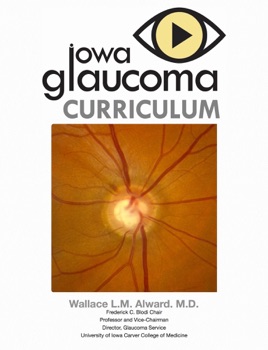Welcome to the Iowa Glaucoma Curriculum

This is a teaching site for residents and others interested in learning about glaucoma.
It breaks glaucoma into fifty bite-sized lectures that average 14 minutes in length (range 4 to 37 minutes).
In total the curriculum is just under 12 hours long.
It is highly visual with >900 images and >90 movie clips.
Taking care of glaucoma can be very hard, but I am hoping that I have made learning about this family of diseases somewhat easier....
The Iowa Glaucoma Curriculum
The Curriculum Chapters
PREFACE: What is glaucoma and why does it matter
I. BASIC SCIENCES
CHAPTER 1: Aqueous humor dynamics, anterior chamber anatomy and ciliary body
CHAPTER 2: Optic nerve and nerve fiber layer anatomy
II. EXAMINATION
CHAPTER 3: Intraocular pressure and tonometry
CHAPTER 4: Gonioscopy and Imaging the angle (UBM, AS-OCT)
CHAPTER 5: Perimetry principles types of perimetry: Kinetic, static threshold, SWAP, FDT
CHAPTER 6: Automated Perimetry - Interpreting a Field
CHAPTER 7: Visual Field Changes in Glaucoma
CHAPTER 8: Perimetry Quiz
CHAPTER 9: Optic Nerve Head and Nerve Fiber Layer Changes in Glaucoma
Supplementary Material
III. CLASSIFICATION OF THE GLAUCOMAS
CHAPTER 10: Classification of the glaucomas
IV. DEVELOPMENTAL GLAUCOMAS
CHAPTER 11: Primary Congenital Glaucoma
CHAPTER 12: Axenfeld-Rieger Syndrome, Peters Anomaly
CHAPTER 13: Aniridia, Phacomatoses, and Other Glaucomas of Infancy and Childhood
V. PRIMARY OPEN ANGLE GLAUCOMAS
CHAPTER 14: Primary Open Angle Glaucoma, Juvenile Open Angle Glaucoma (EMGT)
CHAPTER 15: Ocular Hypertension and Glaucoma Suspects (OHTS)
CHAPTER 16: Normal Tension Glaucoma (CNTGTS, LOGTS)
VI. PRIMARY ANGLE CLOSURE GLAUCOMAS
CHAPTER 17: Primary Pupillary Block Angle Closure Glaucoma, Nanophthalmos, MMG
CHAPTER 18: Plateau Iris Syndrome
CHAPTER 19: Malignant Glaucoma
VII. SECONDARY GLAUCOMAS
CHAPTER 20: Exfoliation Syndrome
CHAPTER 21: Pigment Dispersion Syndrome and Pigmentary Glaucoma
CHAPTER 22: Corticosteroid-induced Glaucoma
CHAPTER 23: Glaucoma Secondary to Inflammation
CHAPTER 24: Glaucomatocyclitic Crisis
CHAPTER 25: Fuchs Heterochromic Iridocyclitis
CHAPTER 26: Trauma-associated Glaucomas (Angle Recession, hyphema, Ghost Cell, Siderosis, Burns)
CHAPTER 27: Lens-associated Glaucomas
CHAPTER 28: Post-surgical Glaucoma (Aphakic, Epithelial Downgrowth, Post-PK, Post DSEK)
CHAPTER 29: Elevated Episcleral Venous Pressure
CHAPTER 30: Glaucoma Secondary to Tumors and Cysts
CHAPTER 31: Neovascular Glaucoma
CHAPTER 32: The Iridocorneal Endothelial Syndromes
CHAPTER 33: Miscellaneous (Iridoschisis, PPMD, CB Swelling, Schwartz)
VIII. PRINCIPLES OF GLAUCOMA MANAGEMENT
CHAPTER 34: General Principles of Glaucoma Management
Supplementary Material
CHAPTER 35: Glaucoma Management Studies (CIGTS, AGIS)
IX. MEDICAL MANAGEMENT
CHAPTER 36: Prostaglandin Analogs
CHAPTER 37: Beta Adrenergic Antagonists
CHAPTER 38: Adrenergic Agonists
CHAPTER 39: Carbonic Anhydrase Inhibitors
CHAPTER 40: Trabecular Meshwork Outflow Agents
CHAPTER 41: Hyperosmotic Agents
X. SURGICAL MANAGEMENT
CHAPTER 42: Laser Trabeculoplasty (GLT)
CHAPTER 43: Iridotomy and Iridoplasty
CHAPTER 44: Trabeculectomy, Express shunt (5FU study)
CHAPTER 45: Glaucoma Drainage Devices
CHAPTER 46: Surgery for Glaucomas of Infancy
CHAPTER 47: Cataract Surgery in the Glaucoma Patient
CHAPTER 48: Minimally Invasive and Other Glaucoma Surgeries
Supplementary Material
CHAPTER 49: Cyclodestructive Procedures
XI. HYPOTONY
CHAPTER 50: Hypotony


No comments:
Post a Comment